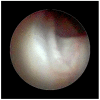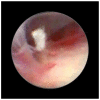The Dorsomedian Ligamentous Strand: An Evaluation In Vivo with Epiduroscopy
- PMID: 35323217
- PMCID: PMC8955851
- DOI: 10.3390/medsci10010018
The Dorsomedian Ligamentous Strand: An Evaluation In Vivo with Epiduroscopy
Abstract
Several anatomical studies have described the morphology of the spinal space; however, researchers do not all agree on the presence of the dorsomedian ligamentous strand (DLS), which divides the epidural space. The possible existence of this structure still influences some clinical practice, such as locoregional anesthesia and pain therapy. Since the number of procedures occurring inside the epidural space have increased, this study's primary objective was to describe the composition of this space through epiduroscopy. We conducted a retrospective analysis of video recorded during epiduroscopy. Two independent doctors performed blind analyses of morphological aspects of peridural space visualized during the procedure in each patient for the maximum possible extension depending on the underlying pathology in the tract from S1 to L1. We enrolled 106 patients who underwent epiduroscopy; 100% of patients presented no medial longitudinal segmentation dividing the epidural channel at any level of the spinal tract investigated, including in the epidural space with pathological fibrotic scars and in those with no adherence. The main finding of our study was the visual absence of any anatomical structure dividing the epidural channel. We report that in vivo, in our experience, with direct epiduroscopy, the DLS is not visible.
Keywords: dorsomedial ligamentous strand; epidural space; epiduroscopy; interventional pain procedure.
Conflict of interest statement
The authors declare no conflict of interest.
Figures
References
-
- Husemeyer R.P., White D.C. Topography of the lumbar epidural space. A study in cadavers using injected polyester resin. Anaesthesia. 1980;35:7–11. - PubMed
-
- Stevens D.S., Balkany A.D. Appearance of plica mediana dorsalis during epidurography. Pain Phys. 2006;9:268–270. - PubMed
-
- Luyendijk W. Canalography. Roentgenological examination of the peridural space in the lumbo-sacral part of the vertebral canal. J. Belg. Radiol. 1963;46:236–254. - PubMed
MeSH terms
LinkOut - more resources
Full Text Sources
Medical





